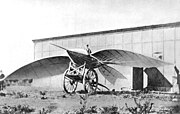The dream of flight goes back to the days of pre-history. Many stories from antiquity involve flight, such as the Greek legend of Icarus and Daedalus, and the Vimana in ancient Indian epics. The first recorded attempts at aviation were made by Yuan Huangtou and Abbas Ibn Firnas. Leonardo da Vinci drew an aircraft in the 15th century. Francois Pilatre de Rozier and Francois d'Arlandes flew in an aircraft lighter than air, a balloon. The biggest challenge became to create other craft, capable of controlled flight.

Sir George Cayley, the inventor of the science of aerodynamics, was building and flying models of fixed-wing aircraft as early as 1803, and he built a successful passenger-carrying glider in 1853.[2] In 1856, Frenchman Jean-Marie Le Bris made the first powered flight, by having his glider "L'Albatros artificiel" pulled by a horse on a beach. On 28 August 1883, the American John J. Montgomery made a controlled flight in a glider. Other aviators who had made similar flights at that time were Otto Lilienthal, Percy Pilcher and Octave Chanute.
Self-powered aircraft were designed and constructed by Clément Ader. On October 9, 1890, Ader attempted to fly the Éole, which succeeded in taking off and flying uncontrolled a distance of approximately 50 meters before witnesses. In August 1892 the Avion II flew for a distance of 200 metres, and on October 14, 1897, Avion III flew a distance of more than 300 metres. Richard Pearse made a poorly documented uncontrolled flight on March 31, 1903 in Waitohi, New Zealand, and on August 28, 1903 in Hanover, the German Karl Jatho made his first flight.
The Wright Brothers are commonly credited with the invention of the powered controllable aircraft in the English speaking world[1]. They made their first successful test flights on December 17, 1903 and by 1905 Wright Flyer III was capable of fully controllable, stable flight for substantial periods. Strictly speaking, the Flyer's wings were not completely fixed, as it depended for stability on a flexing mechanism named wing warping. This was later superseded by the development of ailerons, devices which performed a similar function but were attached to an otherwise rigid wing.
Alberto Santos-Dumont a Brazilian living in France, built the first practical dirigible balloons from the end of the nineteenth century. In 1906 he flew the first fixed wing aircraft in Europe, the 14-bis, which was of his and Gabriel Voisin's design. It was the first aircraft to take off, fly and land without the use of catapults, high winds, or other external assistance. A later design of his, the Demoiselle, introduced ailerons and brought all around pilot control during a flight. In Brazil, Santos-Dumont is put forward as the true inventor of the aircraft, but owing to the competing claims, the concept of the invention of the first flying machine has substantial ambiguity.
Wars in Europe, in particular World War I, served as initial tests for the use of the aircraft as a weapon. First seen by generals and commanders as a "toy", the aircraft proved to be a machine of war capable of causing casualties to the enemy. In the first world war, the fighter "aces" appeared, of which the greatest was the German Manfred von Richthofen, commonly called the Red Baron. On the side of the allies, the ace with the highest number of downed aircraft was René Fonck, of France.
After the First World War, aircraft technology continued to develop. Alcock and Brown crossed the Atlantic non-stop for the first time in 1919, a feat first performed solo by Charles Lindbergh in 1927. The first commercial flights took place between the United States and Canada in 1919. The turbine or the jet engine was in development in the 1930s; military jet aircraft began operating in the 1940s.
Aircraft played a primary role in the Second World War, having a presence in all the major battles of the war, especially in the attack on Pearl Harbor, the battles of the Pacific, as well as the Battle of Britain. They were also an essential part of several of the military strategies of the period, such as the German Blitzkrieg or the American and Japanese Aircraft carriers.
In October 1947, Chuck Yeager was the first person to exceed the speed of sound, flying the Bell X-1.
Aircraft in a civil military role continued to feed and supply Berlin in 1948, when access to railroads and roads to the city, completely surrounded by Eastern Germany, were blocked, by order of the Soviet Union.
The first commercial jet, the de Havilland Comet, was introduced in 1952. A few Boeing 707s, the first widely successful commercial jet, are still in service after nearly 50 years. The Boeing 727 was another widely used passenger aircraft, and the Boeing 747 was the biggest commercial aircraft in the world up until 2005, when it was surpassed by the Airbus A380.

No comments:
Post a Comment